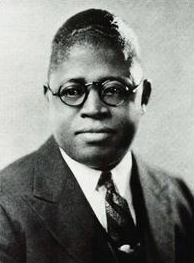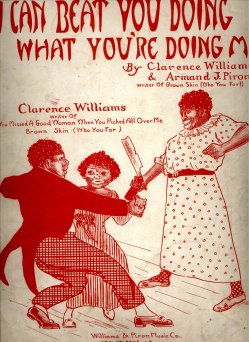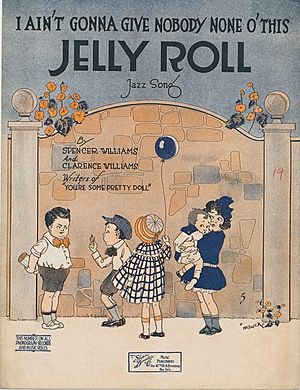Clarence Williams (musician) facts for kids
Quick facts for kids
Clarence Williams
|
|
|---|---|
 |
|
| Background information | |
| Born | October 8, 1893 or October 8, 1898 (sources differ) Plaquemine, Louisiana, U.S. |
| Died | November 6, 1965 (age 67 or 72) Queens, New York City |
| Genres | Jazz |
| Occupation(s) | Musician, composer |
| Instruments | Piano |
| Associated acts | Sidney Bechet, Louis Armstrong, Bessie Smith, Eva Taylor |
Clarence Williams was an important American musician. He was a talented jazz pianist, a composer, and even a singer. He also worked as a promoter, helping other artists, and published music. He was born on October 6, 1898, or October 8, 1893 (sources differ), and passed away on November 6, 1965.
Contents
Early Life and Career
Clarence Williams was born in Plaquemine, Louisiana. His father, Dennis, was a bassist. When Clarence was just 12 years old, he left home. He joined a traveling show called Billy Kersands' Minstrel Show. After that, he moved to New Orleans.
In New Orleans, Clarence first did small jobs like shining shoes. Soon, people noticed his singing talent. He became known as a singer and a master of ceremonies. By the early 1910s, he was a popular local entertainer. He also started playing the piano and writing new songs by 1913.
Clarence was a smart businessman. He helped organize and manage entertainment. He worked at local African American vaudeville theaters. He also managed shows at saloons and dance halls. Many of these places were around Rampart Street and in Storyville.
Music Publishing and Recording
In 1915, Clarence Williams started a music publishing company. He partnered with violinist and bandleader Armand J. Piron. By the 1920s, their company was very successful. It became the top African-American owned music publisher in the country.
Clarence briefly toured with W. C. Handy. He then opened a publishing office in Chicago. In the early 1920s, he moved to New York. In 1921, he married blues singer and actress Eva Taylor. They often performed together.
Clarence was a main pianist on many blues records. These were recorded in New York during the 1920s. He oversaw recordings for Okeh phonograph company. He helped create their "race series" for African American artists. He found many artists who recorded for the label.
He also recorded a lot of his own music. He led studio bands for Okeh and Columbia. Sometimes he recorded for other labels too.

Leading Bands and Collaborations
Clarence Williams often used "Clarence Williams' Jazz Kings" for his hot jazz songs. For his washboard songs, he used "Clarence Williams' Washboard Five." He also helped produce early recordings by famous musicians. These included Louis Armstrong, Sidney Bechet, Bessie Smith, and his niece Katherine Henderson.
Two of his bands from 1924 were very special. "The Red Onion Jazz Babies" and "Clarence Williams' Blue Five" featured Armstrong and Bechet. These two were very important early jazz soloists. Their recordings together from this time are unique.
Clarence Williams' Blue Five was a studio band. It formed after King Oliver's successful recordings. They wanted to explore the market for blues music. Armstrong and Bechet sometimes tried to play better than each other. This can be heard in "Cake Walkin' Babies from Home." This is one of their most famous performances. It was recorded by both bands. Even with some rivalry, they also worked well together. For example, they shared a musical break in "Texas Moaner Blues." King Oliver also played cornet on some of Williams's recordings in the late 1920s.
Most of Clarence's recordings were songs from his own publishing house. This is why he recorded songs like "Baby Won't You Please Come Home" many times. One of his own songs was "Shout, Sister, Shout" (1929). He recorded it, and the Boswell Sisters also covered it in 1931.
In 1933, he signed with the Vocalion label. He recorded many songs with washboard percussion until 1935. He also recorded for Bluebird in 1937 and 1941.
Later Life and Legacy
In 1943, Clarence Williams sold his large collection of songs. He sold them to Decca Records for $50,000. After this, he retired from music. He then bought a used-goods store called the Harlem Thrift Shop.
Clarence Williams passed away in Queens, New York City, in 1965. He was buried in Saint Charles Cemetery in Farmingdale. His wife, Eva Taylor, was buried next to him when she passed away in 1977.
Personal Life
Clarence Williams' grandson is the actor Clarence Williams III.
Work and Influence
Clarence Williams' name appears as composer on many songs. He sometimes bought the rights to songs written by others. This was a common practice in the music business back then. He is also credited for Hank Williams' 1949 hit "My Bucket's Got a Hole in It." Louis Armstrong later recorded this song too. In 1970, Clarence Williams was honored. He was added to the Songwriters Hall of Fame after his death.
Famous Songs
Here are some songs Clarence Williams was involved with:
- "I Wish I Could Shimmy Like My Sister Kate" (as publisher)
- "I Ain't Gonna Give Nobody None o' this Jelly-Roll" (with Spencer Williams, 1919)
- "Sugar Blues" (1919)
- "Baby Won't You Please Come Home" (1919)
- "Royal Garden Blues" (with Spencer Williams, 1919)
- "Ain't Nobody's Business If I Do" (and others, 1922)
- "Shout, Sister, Shout"
- "You Missed A Good Woman"
- "That Ought To Do It"
- "Look What A Fool I've Been"
- "Got To Cool My Doggies Now"
- "I Can Beat You Doing What You're Doing Me"
- "Need a Little Sugar in My Bowl" (1931)
- "My Bucket's Got a Hole in It" (1933)
See also
 In Spanish: Clarence Williams para niños
In Spanish: Clarence Williams para niños
- Big band
- List of American big band bandleaders
- List of big bands


